Did your excitement to purchase a recreational vehicle end when you became overwhelmed by the choices available in RVs? Don’t feel alone, the array of camper styles on the market today is mind-blowing. Let me help you end “camper confusion” with this comprehensive guide that explains the 11 different RV types available, what items you need for them, the ideal places to take them, and the number of people they comfortably fit.
Read along to learn more about RV types so you can find the perfect camper for you!
The 11 RV Types
Recreational vehicles come in many different styles. Each group within that style has unique benefits and needs. There are campers you drive, campers you pull, and campers made for seasonal or long-term use.
The following are the RV types I will discuss from smallest to largest:
- Teardrop Trailer
- Truck Camper
- Pop-up Camper
- Hybrid Trailer
- School Bus and Cargo Conversion
- Travel Trailer
- Class B RV
- Class C RV
- Fifth-Wheel Trailer
- Class A RV
- Park Model
Next, I will break down the variations among each group, and any special considerations that apply when using that particular camper.
What Is a Teardrop Trailer?
A teardrop trailer or camper has a compact, lightweight design that derives its name from its iconic teardrop shape. Teardrops are typically small and meant for two adults. Newer models are becoming quite large and offer a full range of amenities found in most standard RVs. Teardrop trailers are aerodynamic and easy to pull, which saves on fuel expenses.
Teardrop trailers are becoming very popular due to their compact size that makes it easy to pull by car or motorcycle.
Teardrop campers are a practical solution for those who want more comfort and protection than using a tent and want a camper that is easy to park, store, and set up just about anywhere. The average length of teardrops is four to ten feet long.
Although some larger teardrop campers have kitchen or toilet options, most do not. You will have to bring a grill for cooking, a 12-volt space heater or heated blanket for chilly nights, and gallons of drinkable water.
These are unbeatable for ease of use on short weekend camping trips. Another great feature is that you can stow your camping gear safely inside, which eliminates the need to pack and unpack supplies every time you wish to camp.
You can even buy a teardrop with rugged tires which enables you to take it to backcountry locations, off the grid, off the road, to the beach, as well as setting up at regular campgrounds.
What Is a Truck Camper?
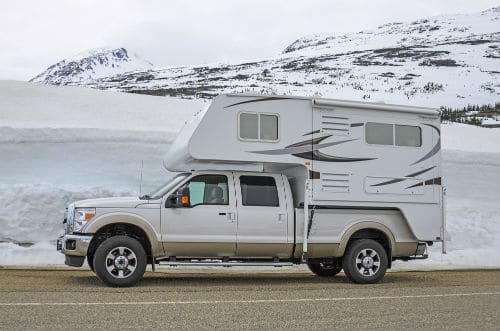
Known to many in the RV community as a “TC”, a truck camper refers to any recreational vehicle that sits in the bed of a pickup truck. These campers can be set down at the campsite and allow you to utilize your truck for sightseeing or trips or shopping. Sometimes people refer to a truck camper as a cab-over or slide-in camper.
A truck camper is a recreational vehicle that you mount temporarily or permanently into the bed of a pickup truck. Models can be bare-bones or feature bathrooms and slide-outs. Most are eight to 12-feet in length.
Truck campers are for those who want to utilize their current truck, yet don’t want to invest in a travel trailer or motorhome. Camping safely with protection from the elements, and being able to have full use of your truck are the most significant benefits to owning a truck camper.
I have seen campgrounds that do not accept truck campers, so keep this in mind and always call ahead to check your status. Of course, this is not a concern if you choose to camp in more remote settings.
Having a portable solar power system in your truck camper is very versatile and allows you to charge phones and use lights anywhere you camp.
Extra tie-downs are a must in the event one of your straps breaks during travel. It also won’t hurt to have a portable water filtration system and composting toilet if you are going off the grid to camp.
Common uses for truck campers are for hunting and fishing expeditions into the backwoods, or anywhere you can drive your truck. Although I’ve seen seasonal campers in them, they are best for trips shorter than a week for one to two people.
What Is a Pop-Up Camper?
A pop-up camper is a pull-behind type of RV that collapses into a compact box for easy transport and storage. A favorite camper for families because when set up, this type of camping trailer folds out to allow a large amount of interior space for sleeping and hanging out. A pop-up camper is an affordable choice for those looking for more comfort and protection than you can get from a tent.
Pop-up campers are any type of fold up tent trailer that collapses into a box for towing and storage.
Between the fancy new designs and the convenience of these units, they are making a resurgence in the camping market. Pop-ups range in length from eight to 16 feet and are towable by most vehicles such as trucks, SUVs, crossovers, sedans, and even some compact cars.
They protect you better from the weather but provide less sound protection or privacy from other campers. Extra space heaters and fans will be necessary to maintain interior temperature control.
You’ll need to carry a supply of repair tape in case the fabric on your pop-out section tears. Plastic totes are handy for clothing and food since there’s no place to store them while the camper is collapsed but on the floor of your camper.
Installing a front trunk on the camper is very beneficial for storing wheel chocks, the winch to raise and lower the roof, and your emergency toolbox.
A pop-up camper is fitting for weekend escapes up to weeklong trips. You can pull them into remote locations, and because they incorporate pull-out bunks, they are exceptional for a couple with one or two small children.
What Is a Hybrid Trailer?
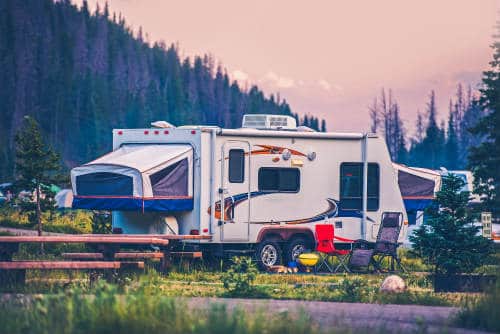
The hybrid travel trailer is a cross between a tent-style camper and a hard-sided travel trailer. The ends of the camper fold out to provide sleeping space. Newer models have pop-outs on the side of the camper to extend the dining area. Since it’s towable by many mini-vans and SUVs, the hybrid trailer is another family favorite.
Hybrid or expandable trailers are conventional travel trailers that have additional tent-type extensions to expand space. The relatively lightweight trailer is attractive for those who don’t want to upgrade to a vehicle with more towing capacity.
Some hybrids have sleeping areas that fold out as you see in a pop-up camper, some have a push-up roof with screen or tent-like sides. Most hybrids include a bathroom and kitchen area, which make them more appealing than a traditional pop-up camper.
Because the bunk ends are screening and fabric, temperature control is difficult. You’ll need to carry fans for summer and space heaters for colder weather.
Hybrids lack in storage space, which means you may have to carry your camping gear like folding chairs, grills, and coolers in your tow vehicle.
The added space of these extensions makes hybrid trailers a good selection for couples with small children to take on backwoods camping trips or to regular campgrounds for weekends or weeklong excursions.
School Bus and Cargo Trailer Conversions
People make conversion campers from an old school bus or a new or used cargo trailer – commonly called a “skoolie”. In a school bus conversion, people retrofit plumbing, appliances, and furniture to make the bus into a spacious RV. A standard enclosed cargo trailer is another option that people transform into a camper. These types of conversions often have issues gaining entry into campgrounds because they aren’t RVIA certified campers.
School bus and cargo trailer conversions are fairly common in the camping world. Both of these types of RV conversions have their positives and negatives, so knowing exactly where and when you will be camping will determine if this is the right option for you.
What Is a School Bus Conversion?
A commercial school bus RV conversion can be bought fairly cheaply and provide lots of interior space to fit a larger family.
The addition of kitchen and toilet facilities, as well as propane heaters, make these appear like traditional RVs on the inside, yet the outside remains looking like a school bus, no matter what color you paint it.
What Is a Cargo Trailer Conversion?
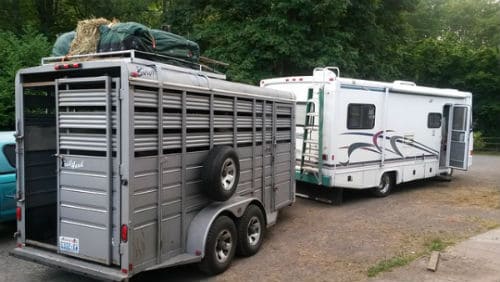
Private people or outdoor companies like to convert plain cargo trailers with living spaces which are becoming popular with campers.
The biggest giveaway the unit started as a cargo trailer is the lack of windows. Most cargo trailer conversions do not bother with bathroom facilities but do have water hookups for a sink. DIY enthusiasts like the customization possibilities of cargo trailers and the ability to control cost expenditures.
School bus and cargo trailer conversions are good for weekend escapes, with longer trips easier to handle as you add more amenities to the interior. Since wiring these for RV types power is uncommon, you will always have to carry a generator or plenty of extension cords to reach any possible power source to run lights or outlets.
The biggest issue with these types of conversions is many campgrounds do not allow them, or only let them in on a case by case basis. That is why these styles of campers are best for off-grid destinations like remote state parks, deserts, and beach areas where rules are more relaxed.
On the bright side, there are many rallies held around the country to show off your school bus conversion.
What Is a Travel Trailer?
A travel trailer is a tow-behind camper that provides the comforts of home while traveling. Sleeping quarters, kitchens, and bathrooms make vacations cost-effective and fun. Also known as a caravan, pull-behind, bumper-pull, or camper trailer, a travel trailer can have the basics for daily needs, or be lavishly outfitted.
Travel trailers have rigid sides that you tow with a pickup truck, SUV, or large crossover via a hitch.
Possibly the most common of all recreational vehicles, there are models to suit just about anyone’s camping needs. From simple units with no slide-outs to units with two, three, or even four slides and tons of amenities are available.
Most travel trailers range from 18 feet to 34 feet long. The longer the trailer, the larger your tow vehicle needs to be to pull it safely. Bumper or frame hitches connect to the tongue of the camper and disconnect at the campsite, for full use of your tow vehicle.
Travel trailers are more like a tiny home, and therefore people expect the comforts of home while camping. That is why you should always carry a 25-50 foot length of coaxial cable to hook up to a park’s TV system.
You should also carry 15, 30 and 50-amp power converters so you can have at least some power if your pedestal’s breakers are faulty, and a sewer donut for a tight wastewater connection if the park does not have screw-in type fittings.
Travel trailers are an affordable choice for a week, month, or seasonal stay at campgrounds for any size group. These are also easy to retrofit for solar power if you choose to camp off-grid for any length of time.
What Is a Class B RV?
A Class B RV or motorhome looks like a sleek oversize van and is sometimes called a campervan. The ceilings are lifted in Class B motorhomes to accommodate a person to stand fully upright inside. These motorhomes are the best on fuel economy and are very easy to drive and park.
I have seen a surge of Class B RVs (often also referred to as Class B motorhomes) in campgrounds and on the road. Class B units are built on a conventional or Sprinter-type van chassis, to which alterations are in the body like a raised roof.
With great gas mileage for an RV, and available in gas or diesel options, Class B RV are easy to park just about anywhere. Regulations classify a van to be a Class B RV when they include:
- A refrigerator
- A toilet
- AC unit and heater
- 110v electrical system
- Cooking equipment
- Water system with sink/shower
These RV types do not offer slide-outs, and you should think of them as a van with amenities. Carrying a spare tire and appropriate tools is critical. Inside space is very limited, so an outdoor table and chair set is also important.
If you have the option of adding an awning to the outside, do it. An awning allows for extra shade to keep your camper interior cooler, as well as protection from light rains when sitting outside.
Class B RVs are the most affordable option in this category of driveable RVs. Due to ease of parking, they are great for constant travel to many places, city or rural. If you are a single or couple looking to explore the country, Class B is a fantastic option.
What Is a Class C RV?
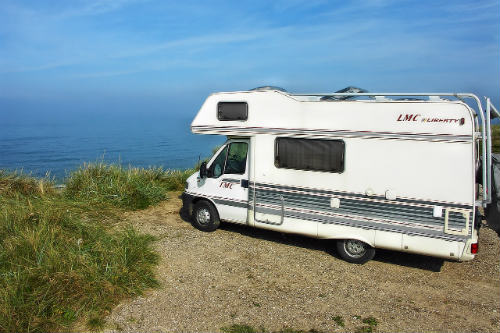
A Class C RV or motorhome is a mid-size recreational vehicle built on a van or truck chassis specifically made to handle the extra weight of the camper framing and interior amenities. The driver’s cab features an overhang that holds a platform for sleeping quarters or extra storage. Most sleep 4-6 people comfortably.
A Class C RV (also referred to as a Class C motorhome) is the most recognizable of all recreational vehicles. Built on a truck platform, it has a front engine with a cab-over above the driver compartment.
Class C RVs can run on gas or diesel and come in lengths from 16 feet to 36 feet. The engine and chassis can allow for additional towing of a vehicle for those who wish to explore an area further after reaching their camping destination.
The cab-over compartment is usually a bed, but can also be for a TV and entertainment system, or added storage. Class C RVs are full of equipment to provide comfort while camping. Refrigerators and freezers, full bathrooms, water heaters, and stoves are standard in most models.
I own this type of camper and can attest to the versatility of this style, but it does have some extras you should always have on hand.
A round bubble level is crucial for leveling the unit. For your fridge and freezer to run correctly and for your shower to drain properly, the RV must be within three inches of level in any direction.
Fortunately, most campground parking pads are within these parameters, but if not, you must always carry leveling blocks to place under tires to level the unit.
Most late-model Class C RVs have hydraulic leveling jacks available that will level up your unit with a push of a button. It will save you hours of stress when trying to set up on an uneven campsite if you can afford the upgrade.
Having a quiet generator will allow you to park at places outside of campgrounds and still have power for making coffee, charging phones, and for lighting.
Class C RVs are great for weekend trips or longer at a campground, or for long road trips around the country. Best for two to four people, which will allow plenty of space for everyone to stretch out.
What Is a Toy Hauler?
A sub-category of recreational vehicle is the toy hauler. Appropriately named, a toy hauler is designed with extra space in the rear of the camper with a fold-down door that turns into a ramp to load an ATV, golf cart, motorcycles, kayaks, or more.
With the front of the toy hauler set up as a traditional camper, it has amenities like a kitchen, bathroom, and bedroom. These are best for those who travel to sports events with their “toys” or like to take their ATVs out to backcountry locations.
Extra straps and tie-downs are a necessity to keep your gear from shifting during travel. A generator that can power the unit’s appliances is also imperative since it’s common for this type of camper to go off-grid.
Toy haulers can be made in Class C, Class A, and fifth-wheel configurations. Many people also transform this additional space for extra bunks for sleeping or as an office.
A toy hauler is excellent for sports enthusiasts who attend ATV, motocross, or motorcycle rallies, and for those who love to fish or kayak.
What Is a Fifth-Wheel Trailer?
Some towable camper trailers use a fifth-wheel configuration hitch that attaches to the bed of a pickup truck, hence the moniker “fifth wheel.” An owner will need a reliable tow vehicle to pull these sizeable campers, buy many people find pulling them to feel much smoother than with a travel trailer. Most fifth-wheels have several slide outs, a large bedroom, and nicely appointed kitchens.
Fifth-wheel travel trailers range in length between 22 feet and up to 45 feet, with the most popular sizes sold in the 32 to 36-foot length. Slideouts are common in the living room, bedroom, and kitchen/dining room area.
Fifth-wheels are made to hitch onto a medium to a heavy-duty truck with an in-bed attachment called a fifth-wheel coupling or gooseneck hitch. Due to the hitch taking up most of the truck’s bed space, it takes away the use of this space for storing camping gear.
Part of the trailer extends over the truck bed, which shortens the total length of the vehicle and trailer combined, which many campers feel is more comfortable to tow. These campers do have interior stairs to reach either the bedroom or living room, so choose a different style of camper if you have mobility issues.
Most fifth-wheel campers have two or three wastewater holding tanks. Having extra lengths of sewer hose is imperative to efficiently reach sewer connections that could be 20-30 feet away from the camper’s sewer line.
A large, powerful generator is another must. If the power goes out, or is not available, running the air conditioner is only possible with a big generator.
Fifth-wheels are the go-to camper for those who want the most in space, amenities, and design, and also want their tow vehicle free for local travel. This camper is great for a week or longer trips for families with kids, or as a seasonal or permanent camper for long-term stays by retirees.
What Is a Class A RV?
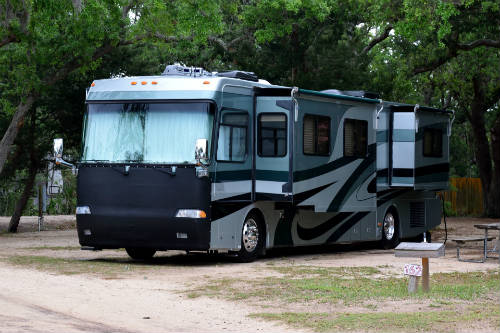
A Class A motorhome or motorcoach starts with a robust commercial truck or bus chassis. Large Class A motorhomes are known to have the worst fuel economy but are very desirable due to first-class design and amenities that make travel luxurious. In some states, you need a special non-commercial license or a commercial driver’s license (CDL) to drive one.
Class A RVs (also referred to as Class A motorhomes) are a driveable recreational vehicle that is built on a commercial truck or bus chassis. Class A RVs
The Class A can range from 20 to 45 feet in length and feature four or five slide-outs and two to three air conditioners. Amazing amenities inside and out make this RV type the favorite for those who want it all while camping. Because of that, you will need to carry a powerful generator to keep things running smoothly.
Unfortunately, you will also need to carry a supply of caulk and waterproofing tape to deal with leaks that are very common on the top of the slide-outs. You must also consider that these will need all the routine maintenance of a small house, along with that of a vehicle so they can be a lot of work.
Another downfall is that older campgrounds have minimal space for an RV in the 40-45 foot length, and you can strain even a 50-amp electrical service by the appliance demands in the larger Class A campers.
Newer campgrounds usually fit the large campers popular today, so make sure you do your research when selecting your camping destination. Overall, for a retired couple looking for a month-long or seasonal stay or long hauls across the country, this unit will have you traveling in comfort and style.
What Is a Park Model?
A park model RV is a trailer-type recreational vehicle made to provide temporary accommodation for camping, recreation, or seasonal use only. You can transport a park model, but their primary design is for long-term placement at a campground and is a favorite for older “snowbirds” who are tired of driving or pulling a camper to their seasonal camping location. This type of camper, built on a flat-bed trailer, must have under 400-square-feet of interior space or they would classify as a manufactured home and be subject to different taxes and regulations.
A park model is a large travel trailer with a design specific for long-term parking, yet be easy to move between campsites or off-site for seasonal storage.
A park model’s interior layout has more space than most other RV types, with slide-outs adding to the dimensions. A park model usually forgoes wastewater holding tanks in exchange for direct plumbing into the sewer system and feature regular flushing toilets, which is a boon for those used to typical RV toilets.
Park models are prevalent in “snowbird” campgrounds where residents drive or fly to the location, and have no desire to move their camper. Usually, they offer only one bedroom, which limits use to a single or couple.
11 RV Types Conclusion
I do hope this guide has clarified the differences between the types of campers available so you can begin your journey in choosing a recreational vehicle.
Watch the below video for even more details about the different RV types available. Locating the right unit for your specific needs will make your camping experience as stress-free and enjoyable as possible.
What RV type is your favorite and why? Share your thoughts and help others find their perfect camper!





Interesting article. I had no idea there were so many different types of RVs.
So many! My favorite is the teardrop camper – hadn’t heard of this one before